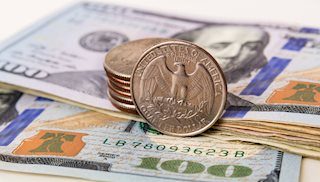US Dollar sees red as dovish bets on the Fed intensify
|
- US Dollar dealt bad hand as market considers higher initial Fed rate cut.
- Market prices in high odds of a 50 bps cut at Wednesday's FOMC meeting.
- Fed Dot Plot unlikely to validate an aggressive rate path.
The US Dollar Index (DXY), which measures the value of the USD against a basket of six currencies, is extending a corrective decline amid rising dovish expectations for the Federal Reserve's (Fed) meeting on Wednesday. The DXY is trading lower for the third consecutive day, near 100.70, as the market prices in a decently high probability of a 50-basis-point cut.
With signs of a slowdown in inflation and cooling in the labor market, investors have grown confident in a 50 bps cut and over 100 bps of easing by year-end.
Daily digest market movers: US Dollar declines ahead of FOMC meeting
- Fed easing expectations surge ahead of Wednesday's FOMC decision, buoyed by lukewarm inflation data.
- Analysts widely anticipate a 25 bps rate cut, but some project a bolder 50 bps move, while markets price in a 65% chance of the latter.
- Market expectations of 250 bps of easing over the next year are deemed excessive, with the Fed's Dot Plot unlikely to support such an aggressive path.
- FOMC vote will be closely scrutinized for signs of internal divisions.
DXY technical outlook: Indicators resume bearish trend, signs of weakness emerge
Technical indicators for the DXY index have resumed their downward trend in negative territory. The index has broken below its 20-day Simple Moving Average (SMA), indicating a loss of buying momentum. The Relative Strength Index (RSI) is below 50, suggesting further declines. The Moving Average Convergence Divergence (MACD) is also trending lower, confirming the bearish outlook.
Support levels to watch are 100.50, 100.30 and 100.00, while resistance levels to consider are 101.00, 101.30 and 101.60.
Central banks FAQs
Central Banks have a key mandate which is making sure that there is price stability in a country or region. Economies are constantly facing inflation or deflation when prices for certain goods and services are fluctuating. Constant rising prices for the same goods means inflation, constant lowered prices for the same goods means deflation. It is the task of the central bank to keep the demand in line by tweaking its policy rate. For the biggest central banks like the US Federal Reserve (Fed), the European Central Bank (ECB) or the Bank of England (BoE), the mandate is to keep inflation close to 2%.
A central bank has one important tool at its disposal to get inflation higher or lower, and that is by tweaking its benchmark policy rate, commonly known as interest rate. On pre-communicated moments, the central bank will issue a statement with its policy rate and provide additional reasoning on why it is either remaining or changing (cutting or hiking) it. Local banks will adjust their savings and lending rates accordingly, which in turn will make it either harder or easier for people to earn on their savings or for companies to take out loans and make investments in their businesses. When the central bank hikes interest rates substantially, this is called monetary tightening. When it is cutting its benchmark rate, it is called monetary easing.
A central bank is often politically independent. Members of the central bank policy board are passing through a series of panels and hearings before being appointed to a policy board seat. Each member in that board often has a certain conviction on how the central bank should control inflation and the subsequent monetary policy. Members that want a very loose monetary policy, with low rates and cheap lending, to boost the economy substantially while being content to see inflation slightly above 2%, are called ‘doves’. Members that rather want to see higher rates to reward savings and want to keep a lit on inflation at all time are called ‘hawks’ and will not rest until inflation is at or just below 2%.
Normally, there is a chairman or president who leads each meeting, needs to create a consensus between the hawks or doves and has his or her final say when it would come down to a vote split to avoid a 50-50 tie on whether the current policy should be adjusted. The chairman will deliver speeches which often can be followed live, where the current monetary stance and outlook is being communicated. A central bank will try to push forward its monetary policy without triggering violent swings in rates, equities, or its currency. All members of the central bank will channel their stance toward the markets in advance of a policy meeting event. A few days before a policy meeting takes place until the new policy has been communicated, members are forbidden to talk publicly. This is called the blackout period.
Information on these pages contains forward-looking statements that involve risks and uncertainties. Markets and instruments profiled on this page are for informational purposes only and should not in any way come across as a recommendation to buy or sell in these assets. You should do your own thorough research before making any investment decisions. FXStreet does not in any way guarantee that this information is free from mistakes, errors, or material misstatements. It also does not guarantee that this information is of a timely nature. Investing in Open Markets involves a great deal of risk, including the loss of all or a portion of your investment, as well as emotional distress. All risks, losses and costs associated with investing, including total loss of principal, are your responsibility. The views and opinions expressed in this article are those of the authors and do not necessarily reflect the official policy or position of FXStreet nor its advertisers.